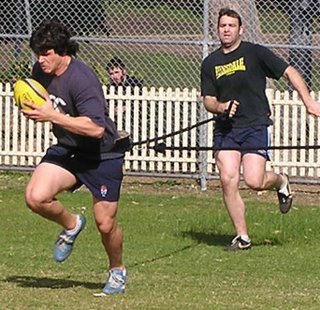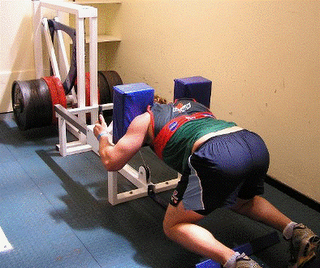Another remarkable statistic is that all but one of the Grand Final winning First Grade team were products of the Club's own Colts program. In recent years Sydney University has become one of the great nurseries of rugby talent, arguably producing more professional players than any other club in the world.
Rugby at the University has evolved into a comprehensive and cohesive system involving the employment of three full-time coaches - Head Coach, Billy Millard; Director of Rugby, Damien Hill; and Colts Coordinator, Nick Ryan.
Over the past three years the Club has been developing an Elite Development Squad (EDS) program for its top grade and colts players. Utilising one of the best equipped gymnasiums in Australian rugby, players train for eleven months of the year and undertake four weights sessions per week off-season and a lesser number while playing. The squad also has on-campus access to physiotherapists, doctors and nutritionists plus regular dietary supplementation. Thus, even though the squad members are not paid, they train in a very professional environment.
Emphasis on basic strength development
Strength and conditioning in the EDS program has been devised and is administered by the University's Athlete Development Manager, Martin Harland. His programs for rugby players place a high degree of emphasis on basic strength development and rugby-specific fitness. A distinguishing feature of his approach is a concentration on heavy lower body work through exercises such as squats, deadlifts and cleans.
Harland's rugby training regimen also requires backs to undertake the same rigorous basic strength routines as forwards. Many strength and conditioning coaches reserve the heavy "grunt" work for forwards, or even restrict it to the tight five. Exposing backs to very serious weight training has produced a quite extraordinary outcome, as outlined in the article, "Building bigger and stronger rugby players - the Sydney University experiment" The average body weight of the 2006 Sydney University First Grade backline was between 2.2 and 4.2kg heavier than that of the backs in the Wallabies and the four Australian Super 14 squads.

Having achieved a strong foundation of basic strength and greater body mass, Martin Harland is then able to focus on speed and explosiveness in his players. The photo at right shows two of those players - Tom Carter and David Lyons whose combined body weight is 225kg - working on developing explosive leg drive on the training paddock.
Use of the ScrumTruk

From the inception of the EDS program the MyoQuip ScrumTruk has been a core component of the strength training of the Sydney University players. It is a rugby-specific apparatus that targets the large mass leg extensor muscles, specifically the gluteal and quadriceps groups.
The ScrumTruk has proven to be of particular value in sports like rugby and rowing where back problems are common. Its operation in the horizontal plane makes it a very effective substitute for the barbell squat.
How well does heavy gym work translate to the playing field?
Size and strength are not necessarily the determining factors in playing success in rugby. Obviously the innate ability of players and the quality of their coaches are the most important ingredients. However, the unprecedented success of the Sydney University Club in the past two seasons suggests that the application of modern strength training techniques has great potential for enhancing individual and team performance. Players can become very significantly bigger and stronger without sacrificing their effectiveness as players.
University's final two First Grade games for the season - both against an equally famous club in Randwick - are confirmation that increased strength and body mass do not have to compromise fitness and mobility.
In the Major Semi-Final University were behind 18-6 with only 10 minutes remaining but managed to draw level at 18-all on the stroke of full-time, sending the match into 10 minutes each way of extra time. University stormed home to a final scoreline of 31-25. Sydney University's own scribe, Graham Croker, noted:
"The innovative and highly successful Harland program bore fruit when the Students lifted the tempo of the game in the closing stages to finish on top as the extra minutes took their toll on the hosts."
Two weeks later the two teams met again in the Grand Final. As the industrious Croker reported:
"The Students led 13-nil after a hard-fought first half, but found themselves with their backs to the wall for much of the second half as Randwick dominated possession and position.
"With the final whistle sounded, the Wicks kept the ball in play metres from the University line for 18 phases – interspersed by a penalty in front of the posts – as the Students tackled themselves to a standstill. ...
"While 16-10 will go in the records as the official score, the more telling statistic was: Sydney University 307 tackles, Randwick 103 tackles.
"Having defeated Randwick in 20 minutes of extra time in the final two weeks earlier, and then held their line for most of the second half in the grand final, fitness and the ability to maintain a defensive structure won the day for the University."
Sydney University's systematic application of the disciplines and structures of professional rugby to a squad of players still in the development phase must surely be a template that other clubs will be driven to emulate.
rugby
Sydney University
strength training
ScrumTruk
Hi Bruce
ReplyDeleteI see one of your coaches might be the Bulls backline coach for S 14 2007.
Would you pls do a bit of a a background article for OORB- I will pass it on to Ruggaworld?
Thanks for the consideration
Oranje
ReplyDeleteI'm intrigued. I haven't heard of this. Do you have more details?
Regards
Bruce
Oranje
ReplyDeleteSomehow I missed your Oranje Orakel Rugby Blog. Never mind, the omission has been rectified. I have just added your site to my blogroll here and also to the Recommended Links and Resources on my main site.
Regards
Bruce
Thanks Bruce
ReplyDeleteIt seems that heyneke Meyer is interested in getting todd Loudon to be a backline coach at the Bulls for 2007
I do not have any specific details - but the Bulls- as most sA teams- can cetainly do with fresh blood coaching the backs.
Interesting about the 'well equiped Gymnasium" at Sydney Uni.
on another topic
I havent read that much on your new competition be tween the States
Do you have good information- or just the url's
Thanks
Bulls wooing exciting Aussie
ReplyDeleteCategories: Super 14 — Posted by Rasputin @ 8:00 am September 25, 2006
Rookie coach impressed after making a secret trip to Pretoria, and is set to become Meyer’s right-hand man
The Bulls are wooing an Australian who has never coached at representative level to be their new backs and attack coach, writes Terry Smith for the Sunday Times.
Todd Louden is an intelligent, articulate, innovative man who was a runaway winner as coach of the year for lifting a Randwick team bereft of Wallabies into the Sydney grand final, in which they were unlucky losers to Sydney University.
Louden made a secret trip to Pretoria with wife Janine, who is expecting their first child in December, to watch the Bulls play in a Currie Cup game against the Sharks. He came home excited about what he had seen.
“I loved it,” he said. “Heyneke Meyer is a phenomenal coach and the place is exploding with talent. There are some big, big boys and Victor Matfield would be in any World XV. I haven’t signed anything but, hopefully, we will have worked out a two-year deal in the coming week.”
The Bulls spoke to several up-and-coming Australian coaches on a recruiting trip to Sydney a month ago and have chosen wisely because Louden has an X-factor that marks him as something special.
He dares to be different.
For instance, when his Randwick players were knocked about by a series of rugged play-off matches in the countdown to the grand final, Louden took them on three trips to a hyperbaric decompression chamber — used by divers with the bends — to get rid of the aches and pains and freshen them up.
Don’t be put off by his lack of experience at the top level of coaching because it is nigh impossible to break into the Super 14 scenario.
Ewen McKenzie is immovable at the Waratahs, ditto John Mitchell at the Western Force and Eddie Jones has taken over the Queensland Reds. Laurie Fisher is held in high regard by the Brumbies.
Tall for a scrumhalf, former schoolteacher Louden looks younger than his 36 years. He played for Australian Schools while at St Edmund’s College in Canberra and, after leaving school, came to Sydney to join the Randwick club.
He played for the Brumbies as George Gregan’s understudy and NSW B, and had a stint in Canada before injury ended a playing career in which he went under the surgeon’s knife 16 times.
Louden coached with success at Meiji University in Tokyo before taking a position as Sydney University’s director of rugby.
He finally became fulltime coach of Randwick this year.
With Janine expecting a baby, Louden had no thoughts of venturing overseas until the Australian Rugby Union made plans for a national competition in which the 12 Sydney clubs would figure in three hybrid teams.
It would be preceded by the traditional club series over three months, for which Randwick’s sagging finances could not justify a fulltime coach.
So circumstances have forced him to look elsewhere, and that’s Australian rugby’s loss.
With the benefit of hindsight, Oranje, it certainly looks as if the Bulls chose well.
ReplyDeleteWhat we are seeing in this year's Super 14 competition is the South African teams improving their standings while it is the Australian outfits that are uncompetitive. Perhaps we will see a reversal of the coaching flow with the Australian franchises hiring South Africans to help lift their standards.
Regards
Bruce
lol, looks like the Aussie teams would do well just to hang onto their own coaches, especially after the Bulls demolished Qld.
ReplyDeleteGood point, pikey, and one that is particularly appropriate to this post, given that it was Todd Louden, now backline coach of the Bulls, who devised the Elite Development Scheme for Sydney Uni Rugby Club when he was its Director of Rugby.
ReplyDeleteTwo South African teams in the Super 14 semis, each with Australian backline coaches - David Campese, of course, looks after the Sharks' backs.
Regards
Bruce